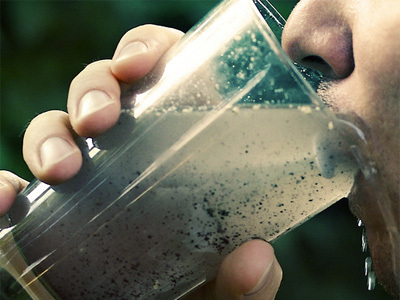Typhoid Fevers: Clinical Significance Of Its Diagnosis, Laboratory Investigations And Prophylaxis
Drinking Of Unclean Water Causes Typhoid Fever

Infectious Diseases
Diagnosis And Clinical Investigations
Diagnosis
Typhoid fever has to be considered in the differential diagnosis of all prolonged febrile illnesses seen in tropical countries. These include hepatic amebiasis, tuberculosis, infective endocarditis, urinary infections, malaria, rheumatic fever, lymphomas, brucellosis, typhus fevers, tularemia, leptospirosis, psittacosis, viral hepatitis, infectious mononucleosis, mycoplasmal pneumonia and others.
Continuous fever with relative bradycardia, coated tongue, timidity of the abdomen, mild hepatosplenomegaly, tenderness and gurgling in the right lower quadrant of the abdomen are features that should suggest the diagnosis of typhoid fever.
Laboratory Investigations
Total leucocyte count is lowered and there is relative lymphocytosis. The diagnosis can be confirmed by isolating the organism from blood, urine or feces and demonstrating rising titers of antibodies. Blood culture is positive in most cases in the first week, thereafter the frequency falls. Culture of the blood clot yields the organisms in a higher proportion of cases. Feces and urine cultures become positive in the second and third weeks of the illness. The feces has to be transported in special media. Bone marrow culture may be positive for S. typhi and this has been resorted to rarely when the other methods fail. In typhoid meningitis, the CSF contains the organisms. Material for culture should be collected before starting antibiotic therapy since drugs sterilize the blood within a short time of administration.
Widal test: This is a test which detects and measures the H and O agglutinins of typhoid and paratyphoid bacilli in the patient’s serum. The antibody titres increase steadily after the first week till the fourth week and then decline. A four-fold rise in the titre of O antibody occurs within a week. The H antibodies also increase but they tend to be less specific than O antibodies. Paratyphoid A and B also share the same type of agglutinins. In any fever, the H antibody may be raised nonspecifically in persons who have received TAB inoculation and it is therefore of limited value in diagnosis in such individuals. The O-agglutinins are of greater value in diagnosis and titer of 1:200 or more is very suggestive. Rising titers demonstrated by repetition of the test at weekly intervals are more diagnostic than single values, even if they are high. The diagnostic titer for amy population has to be fixed taking into consideration the antibody prevalence in the general population.
Counter immunoelectrophoresis (CIE) using antigens prepared from S. typhi may be more helpful in diagnosing, being more specific and less time consuming. For tracing out contracts and in investigating epidermics, the phage typing of S. typhi has to be undertaken.
Regular Washing Of Hands Is A Good Prophylaxis

Prophylaxis
General prophylaxis: Since the disease spreads thorugh food and water, avoidance of food contamination and person hygiene help in reducing the incidence of enteric fever in the community. Provision of protected water supply is perhaps the single most effective measure in the prevention of all water borne infections.
Personal prophylaxis: TAB vaccine is effective in reducing the incidence of the disease. This vaccine contains heat- killed and phenol-preserved S.tyhi, 1000 million and S.paratyphi A and N, 750 million each/ml. The dose for aldults is 0.5ml vaccine on two occasions separated by a period of one to two weeks. Booster doses are required every year to maintain immunity. Vaccination leads to transiet elevation of H-agglutinins and more persistent elevation of H-agglutinins. Oral vaccines are under tial. Preliminary results are encouraging.
© 2014 Funom Theophilus Makama








